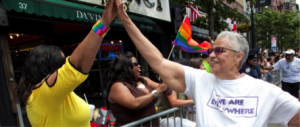Asian American, Pacific Islander, and Native Hawaiian Elders
Debunking the ‘model minority’ myth — we are an incredibly diverse community.
The model minority myth has always been damaging to the Asian American and Pacific Islander (AAPI) elder community because it represents an oversimplified version of the incredibly diverse community. AAPIs are often seen as a minority group with higher income, higher education, lower unemployment, and better health. However, AAPIs represent an incredibly diverse segment of our population with unique challenges.
Asian American and Pacific Islanders represent one of the fastest growing populations of older adults in the United States. Over the next 50 years, the number of AAPIs aged 65 and older is expected to grow more than 350%, from 1.6 million to 7.3 million people. Chinese Americans are the largest Asian ethnic group aged 65 years and older, followed by Filipinos and Japanese. Approximately 85% of AAPIs aged 65 years and older are foreign-born, and only 15% of AAPI elders speak English at home. According to NAPCA’s recent national survey of AAPI-serving community-based organizations (CBOs), three priority issues facing AAPI elders are health, economic security, and language access. Here are three of the biggest challenges facing AAPI elders today:
AAPI elders face chronic health conditions such as diabetes and high blood pressure. Additionally, Southeast Asian American (SEAA) elders (those from Cambodian, Laotian, and Vietnamese descent) face high rates of mental health conditions such as Post-Traumatic Stress Disorder (PTSD) because of their refugee experiences with war trauma, as one example.
AAPI elders are also at higher risk for Hepatitis B, which can lead to liver cancer. Approximately 1 in 12 AAPIs are living with chronic Hepatitis B, and the death rate from Hepatitis B among AAPIs is 7 times greater than rates among whites. Tragically, data also show that older Asian American women have the highest suicide rate of all women over age 65 in the U.S.
Economic, linguistic and cultural challenges in accessing health care services create additional barriers for elders in need.
Many elders within the AAPI community face large socioeconomic challenges. For example, according to the 2010 American Community Survey, more than 18% of SEAA elders are estimated to live in poverty; this is more than twice the estimate for the United States’ elder population as a whole. Additionally, many SEAA workers who have spent careers concentrated in low-wage industries have fewer sources of income, such as 401Ks and pensions, available to them upon retirement.
Chinese, Korean, Vietnamese, and Cambodian older adults, which are among the largest AAPI elder populations, have lower median incomes than the total U.S. population age 65 and older. Additionally, median household incomes of Bhutanese, Cambodians, Koreans, Marshallese, and Hmong age 65 and older fall below median household incomes of Hispanics, American Indians and Alaska Natives, and African Americans.
Almost two-thirds of AAPI elders are limited in their English-speaking ability and one-third are linguistically isolated. In communities where outreach materials are not available in AAPI languages, and where AAPI CBOs and ethnic media do not exist, many AAPI elders are not aware of the resources that are available to them. When resources are available, oftentimes agencies, physicians’ offices, etc. lack bilingual staff that can help interpret for elders. This creates an additional barrier of fear and anxiety in accessing services.
Data on AAPI elders is often presented in aggregate, which belies the diversity that exists within the population and understates many of the challenges faced by this diverse and rapidly growing population. Many AAPI sub-groups are some of the most impoverished in the country.
The family unit is important for support. When it cannot be relied upon, however, AAPI elders have less of a “safety net” due to the high rates of recent immigration, lack of work-based social insurance, lower incomes due to language or non-transferable skills, and other factors. As with other marginalized populations, AAPI elders rely more heavily on Social Security benefits, which make up a larger proportion of their income than their mainstream counterparts.
Due to the high rates of limited English proficiency and the unique challenges faced by many AAPI elders, it is imperative to have culturally- and linguistically-appropriate services and programs for this diverse population.
Our member organization the National Asian Pacific Center on Aging (NAPCA) links culturally and linguistically relevant programs and services to serve the unique needs of AAPI-elders, with high-impact advocacy in partnership with organizations such as the Southeast Asian Resource Action Center (SEARAC). Collectively, NAPCA and SEARAC strive to elevate the diverse voices of AAPI elders in advocating for community-driven policy solutions to improve the well-being of AAPI elders and their families. As members of the Diverse Elders Coalition, NAPCA and SEARAC lend unique community lenses in advocating for collective policies that impact Native American, LGBT, and all elders of color.
For more information about AAPI older adults, visit the website of our member organizations the National Asian Pacific Center on Aging (NAPCA) at napca.org and the Southeast Asian Resource Action Center (SEARAC) at searac.org.





